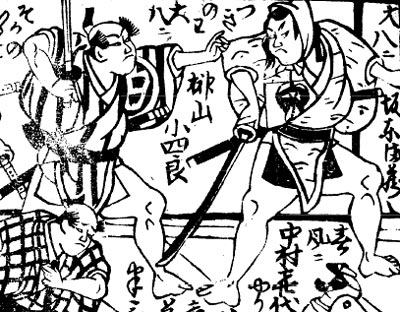| SAKAKIYAMA KOSHIRď III |
|
Stage names:
Line number: SANDAIME (III) Poetry name: Senshi Existence: 1724 ~ 2nd day of the 7th lunar month of 1767 [1] Connection: Father: Sakakiyama Sagisuke Brother: Sakakiyama Koshir˘ IV Disciple: Sakakiyama Shirotar˘ IV Career: 1730s: he started his career as a wakashugata, performing under the name of Sakakiyama Sentar˘. 1738: he received the name of Sakakiyama Jűtar˘ I. Fall 1739: Jűtar˘ went with his father Sakakiyama Shirotar˘ I to ďsaka. 12th lunar month of 1739: Jűtar˘ played in the drama "Kewai Musha ďmi Genji", which was produced at the ďnishi no Shibai by Yoshizawa Ayame II. Fall 1739: Jűtar˘ went back with his father to Ky˘to. 12th lunar month of 1740: Jűtar˘ produced at Hayagumo Ch˘dayű's theater the drama "Chinp˘ Sandai Gatana", which starred his grandfather Sakakiyama Koshir˘ I and his father Sakakiyama Shirotar˘ I. The title of this drama, literally "The Rare Treasure - Three Generations of Swords" [2], was an allusion to the three generations of actors of the Sakakiyama clan sharing the same stage. 8th lunar month of 1741: the play "Shin Usuyuki Monogatari", which was originally written for the puppet theater, was adapted for Kabuki for the first time, in Ky˘to at Hayagumo Ch˘dayű's theater; Jűtar˘ produced it and played the role of Oren [casting]. 15th day of the 6th lunar month of 1747 [3]: his grandfather Sakakiyama Koshir˘ I died. 11th lunar month of 1747: Sakakiyama Shirotar˘ I and Sakakiyama Jűtar˘ I respectively took the names of Sakakiyama Koshir˘ II and Sakakiyama Shirotar˘ II, performing together in the kaomise drama "Teikin ďrai Manzoku Kagami", which was produced by Nakamura Matsubŕ I at the Kitagawa no Shibai; their stage partners were Yamashita Matatar˘ I, Takenaka Heikichi, Fujikawa Heikur˘, Fujioka Daikichi, Nakamura Kiyosabur˘ I, Nakamura Shirogor˘ III, Kasaya Matakur˘ I, Asao Motogor˘ I and Sanogawa Hanazuma II. 11th lunar month of 1749: Shirotar˘ produced at Ebisuya Kichir˘bŕ's theater Fujikawa Sakoku's kaomise drama "Tokitsukazeyasu Keizu". 11th lunar month of 1750: Shirotar˘ produced at Ebisuya Kichir˘bŕ's theater Fujikawa Sakoku's kaomise drama "Taira no Miyako Onna Ez˘shi", in which he played the role of Tatewaki's ny˘b˘ Fuseya 1st lunar month of 1751: Shirotar˘ produced in the same theater Fujikawa Sakoku's ni-no-kawari drama "Keisei Kane-ga-Fuchi", in which he played the role of the keisei Nanaura. 11th lunar month of 1751: Shirotar˘ produced at Miyako Handayű's theater (Minamigawa no Shibai) the kaomise drama "Ky˘ganoko Asahi no Nishiki". 2nd lunar month of 1755: first Kabuki adaptation of the 5 acts puppet theater drama "Ono no T˘fű Aoyagi Suzuri", which was produced by Sawamura Kunitar˘ I and staged at the Minamigawa no Shibai as a kaomise drama; Shirotar˘ played the role of Deba Jir˘'s wife Sasazuru [casting]. 1st lunar month of 1758: first Kabuki adaptation of the puppet theater drama "Gion Sairei Shink˘ki", which was simultaneously produced at the Minamigawa no Shibai [casting] and the Kitagawa no Shibai [casting]. It used its real title at the former theater but it was entitled "Keisei Niwatoriyama" at the latter theater; Shirotar˘ played in the former theater the role of Ubajijű. 1st lunar month of 1766: Shirotar˘'s rank in the Ky˘to hy˘banki, wakaonnagata section, was j˘-j˘-kichi (superior - superior - excellent) [visual]. He shared this rank with Nakamura Kumetar˘ I and Nakamura Kiyosabur˘ I. 11th lunar month of 1766: The actors Sakakiyama Koshir˘ II, Sakakiyama Shirotar˘ II and Sakakiyama Jűtar˘ II respectively took the names of Sakakiyama Sagisuke, Sakakiyama Koshir˘ III and Sakakiyama Shirotar˘ III, performing together in Tenmaya Kyűshichi's kaomise drama "Umayadogimi Shitenn˘ji Kuy˘", which was produced by Edosaka Ky˘emon at the Kitagawa no Shibai. The new Koshir˘ became a tachiyaku actor. 1st lunar month of 1767: Koshir˘'s rank in the Ky˘to hy˘banki, tachiyaku section, was j˘-j˘-(shiro)hankichi (superior - superior - (white) half excellent) [visual]. 2nd day of the 7th lunar month of 1767 [1]: Koshir˘ died in Ky˘to. His father Sakakiyama Sagisuke and his brother Sakakiyama Koshir˘ IV died the following year, the 9th day of the 1st lunar month of 1768 [4] of the former actor and the 7th day of the 3rd lunar month of 1768 [5] for the latter actor. Comments: Sakakiyama Koshir˘ III was a Ky˘to actor, who achieved fame for himself in the Imperial city as an onnagata, reaching the prestigious j˘-j˘-kichi rank in 1766. As the heir of the Sakakiyama clan, he had to swith to tachiyaku roles but died a few months after his shűmei. [1] The 2nd day of the 7th lunar month of the 4th year of the Meiwa era was the 27th of July 1767 in the western calendar. [2] It had also a different suggestive meaning because the word chinp˘ was the penis in old Japanese. [3] The 15th day of the 6th lunar month of the 4th year of the Enky˘ era was the 22nd of July 1747 in the western calendar. [4] The 9th day of the 1st lunar month of the 5th year of the Meiwa era was the 26th of February 1768 in the western calendar. [5] The 7th day of the 3rd lunar month of the 5th year of the Meiwa era was the 23rd of April 1768 in the western calendar. |
 |
|
Sakakiyama Koshir˘ III (left) and Band˘ Manz˘ (right) playing the roles of Tsukinowa Daihachi and Nisemono no Daihachi in the kaomise drama "Umayadogimi Shitenn˘ji Kuy˘", which was staged in the 11th lunar month of 1766 at the Kitagawa no Shibai The Sakakiyama Jűtar˘ line of actors The Sakakiyama Shirotar˘ line of actors The Sakakiyama Koshir˘ line of actors |
|
|
| Contact | Main | Top | Updates | Actors | Plays | Playwrights | Programs | Links | FAQ | Glossary | Chronology | Illustrations | Prints | Characters | Derivatives | Theaters | Coming soon | News |